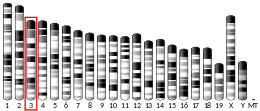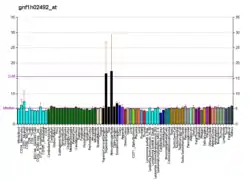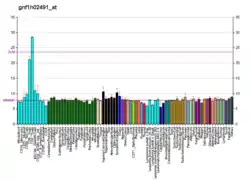| ATP11B | |||||||||||||||||||||||||||||||||||||||||||||||||||
|---|---|---|---|---|---|---|---|---|---|---|---|---|---|---|---|---|---|---|---|---|---|---|---|---|---|---|---|---|---|---|---|---|---|---|---|---|---|---|---|---|---|---|---|---|---|---|---|---|---|---|---|
| Identifiers | |||||||||||||||||||||||||||||||||||||||||||||||||||
| Aliases | ATP11B, ATPIF, ATPIR, ATPase phospholipid transporting 11B (putative) | ||||||||||||||||||||||||||||||||||||||||||||||||||
| External IDs | OMIM: 605869 MGI: 1923545 HomoloGene: 32919 GeneCards: ATP11B | ||||||||||||||||||||||||||||||||||||||||||||||||||
| |||||||||||||||||||||||||||||||||||||||||||||||||||
| |||||||||||||||||||||||||||||||||||||||||||||||||||
| |||||||||||||||||||||||||||||||||||||||||||||||||||
| |||||||||||||||||||||||||||||||||||||||||||||||||||
| |||||||||||||||||||||||||||||||||||||||||||||||||||
| Wikidata | |||||||||||||||||||||||||||||||||||||||||||||||||||
| |||||||||||||||||||||||||||||||||||||||||||||||||||
Probable phospholipid-transporting ATPase IF is an enzyme that in humans is encoded by the ATP11B gene.[5][6][7]
Function
P-type ATPases, such as ATP11B, are phosphorylated in their intermediate state and drive uphill transport of ions across membranes. Several subfamilies of P-type ATPases have been identified. One subfamily transports heavy metal ions, such as Cu(2+) or Cd(2+). Another subfamily transports non-heavy metal ions, such as H(+), Na(+), K(+), or Ca(+). A third subfamily transports amphipaths, such as phosphatidylserine.[7]
References
- 1 2 3 GRCh38: Ensembl release 89: ENSG00000058063 - Ensembl, May 2017
- 1 2 3 GRCm38: Ensembl release 89: ENSMUSG00000037400 - Ensembl, May 2017
- ↑ "Human PubMed Reference:". National Center for Biotechnology Information, U.S. National Library of Medicine.
- ↑ "Mouse PubMed Reference:". National Center for Biotechnology Information, U.S. National Library of Medicine.
- ↑ Nagase T, Ishikawa K, Suyama M, Kikuno R, Hirosawa M, Miyajima N, Tanaka A, Kotani H, Nomura N, Ohara O (Feb 1999). "Prediction of the coding sequences of unidentified human genes. XIII. The complete sequences of 100 new cDNA clones from brain which code for large proteins in vitro". DNA Research. 6 (1): 63–70. doi:10.1093/dnares/6.1.63. PMID 10231032.
- ↑ Halleck MS, Lawler JF JR, Blackshaw S, Gao L, Nagarajan P, Hacker C, Pyle S, Newman JT, Nakanishi Y, Ando H, Weinstock D, Williamson P, Schlegel RA (Nov 1999). "Differential expression of putative transbilayer amphipath transporters". Physiological Genomics. 1 (3): 139–50. doi:10.1152/physiolgenomics.1999.1.3.139. PMID 11015572. S2CID 762447.
- 1 2 "Entrez Gene: ATP11B ATPase, Class VI, type 11B".
External links
- Human ATP11B genome location and ATP11B gene details page in the UCSC Genome Browser.
Further reading
- Halleck MS, Schlegel RA, Williamson PL (Mar 2002). "Reanalysis of ATP11B, a type IV P-type ATPase". The Journal of Biological Chemistry. 277 (12): 9736–40. doi:10.1074/jbc.M200240200. PMID 11790799.
- Dias Neto E, Correa RG, Verjovski-Almeida S, Briones MR, Nagai MA, da Silva W, Zago MA, Bordin S, Costa FF, Goldman GH, Carvalho AF, Matsukuma A, Baia GS, Simpson DH, Brunstein A, de Oliveira PS, Bucher P, Jongeneel CV, O'Hare MJ, Soares F, Brentani RR, Reis LF, de Souza SJ, Simpson AJ (Mar 2000). "Shotgun sequencing of the human transcriptome with ORF expressed sequence tags". Proceedings of the National Academy of Sciences of the United States of America. 97 (7): 3491–6. Bibcode:2000PNAS...97.3491D. doi:10.1073/pnas.97.7.3491. PMC 16267. PMID 10737800.
This article is issued from Wikipedia. The text is licensed under Creative Commons - Attribution - Sharealike. Additional terms may apply for the media files.






